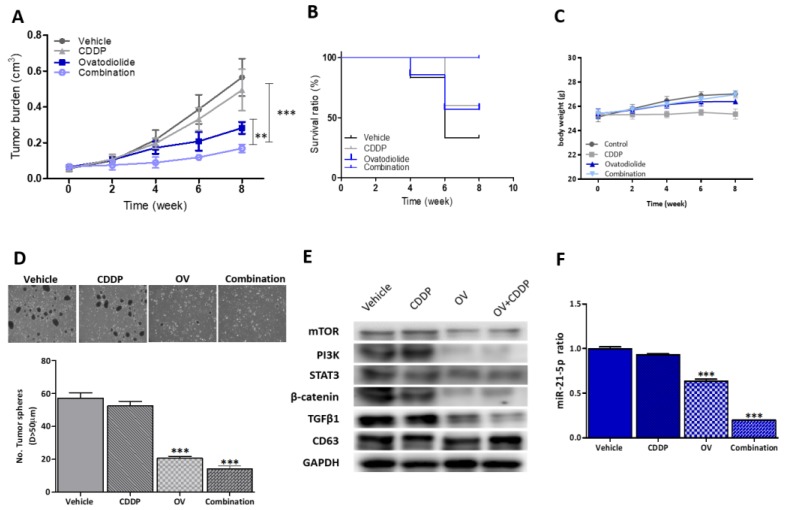Figure 6.
Ovatodiolide (OV) suppresses cisplatin (CDDP)-resistant CAL27 cancer stem cells (CSCs) in vivo. (A) Tumor volume versus time curve. The combination of OV+CDDP showed the most significant tumor suppressive effect followed by OV-only treatment, while groups treated with CDDP-only or the vehicle showed the largest tumor volumes. (B) Kaplan-Meier survival curve. Mice that received the combined OV+CDDP regimen showed the highest survival ratio followed by the OV-only group, while CDDP-only and vehicle mice showed the lowest survival ratios. (C) The body weight over time curve shows that all mice exhibited a steady increase in body weight over time, except for a slight decrease in mice which received the CDDP regimen. This suggests no apparent systemic toxicity of OV treatment. (D) Comparative tumor sphere-forming assay. Tumor samples collected from all experimental groups showed that OV+CDDP samples were the least capable of generating tumor spheres followed by the OV-only regimen, while the CDDP and vehicle groups were indifferent. (E) Western blots of extracellular vesicles (EVs) collected from all experimental groups. EVs from OV+CDDP and OV-only regimens showed a markedly lower level of mammalian target of rapamycin (mTOR), phosphatidylinositol-3 kinase (PI3K), and β-catenin compared to those from the vehicle and CDDP-only groups. Cluster of differentiation 63 (CD63) was used as a marker of EVs and a loading control. (F) The qPCR analysis showed the lowest level of miR-21-5p in EVs collected from the combined OV+CDDP regimen followed by OV-only, while there was no significant difference between the vehicle and CDDP-only groups. ** p < 0.01; *** p < 0.001.

